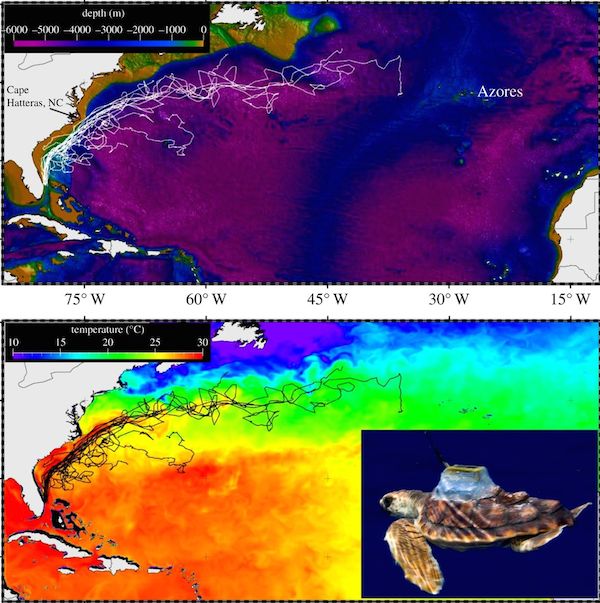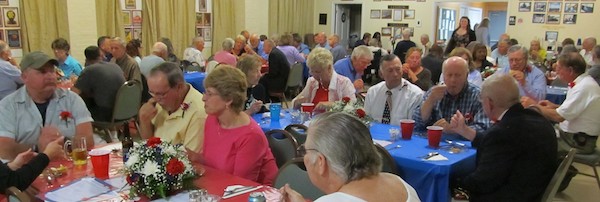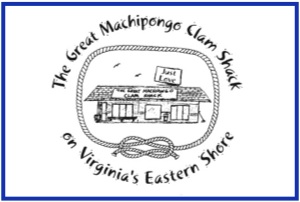WAYNE CREED
Wake Up to Danger of Saltwater Intrusion
By WAYNE CREED
July 21, 2014
A few nights ago, plagued by a fit of insomnia, I downloaded a copy of the Cape Charles Planning Commission’s June 30 meeting agenda. Hoping the content would induce a much needed sleep, I quietly perused the document. As usual, it was filled with the same vapid and gooey pap that has come to define the Natali-McCoy Planning Commission. There was some talk of promoting a museum for the Chesapeake Bay Impact Crater, but then, buried deep down in the weeds, a discussion of saltwater intrusion, and how it will affect the Town. In a cavalier, dim, nonchalant tone, it states:
The Town has limited groundwater resources. In the future, saltwater intrusion may necessitate the Town update water treatment technologies or possibly obtain water from a different location.
So, what are they talking about? In a nutshell, saltwater intrusion (high concentrations of total dissolved solids making it unfit for human consumption) is the movement of saline water into freshwater aquifers. Aquifers are saturated geologic materials that yield usable quantities of drinking water to wells. In our case, we rely on the Columbia and Yorktown-Eastover aquifers and there are no other viable economical alternative drinking water sources. The Columbia and Yorktown-Eastover aquifer is considered highly vulnerable to salt water contamination due to the high levels of ground-water pumping from coastal wells (like our Keck wells). As towns like Cape Charles continue to over-develop (large developments such as Bay Creek ), ground-water use increases to the point that these areas become vulnerable to contamination and brings into question the viability of ground-water sustainability.
Well drillers around here can attest to the abundance of bad-tasting ground water in parts of southeastern Virginia– a large body of salt water, known as a salt water wedge has been blamed for undrinkable ground water that extends from the mouth of Chesapeake Bay into the Columbia and Yorktown-Eastover aquifers. For many years, scientists thought the wedge was caused by the incomplete flushing of ancient seawater that had invaded the aquifers during high stands of the sea. Understanding of Virginia’s inland saltwater wedge changed in 1993 when David Powars of the U.S. Geological Survey and geologist C. Wylie Poag, while studying the Atlantic Coastal Plain made an important discovery. Deep sedimentary cores identified a large impact crater formed by a meteorite near what is now the mouth of Chesapeake Bay ( three times larger than any other U.S. crater and the sixth largest crater known on Earth). [Read more…]
WEEKEND FEATURE
Remembering the Good Ol’ Days
By ANDY ZAHN
July 12, 2014
All fishermen are liars . . . except you and me — and sometimes I have my doubts about you!
There is a small lake at Fort Lewis, Washington, and it is in the artillery impact range where often they fire 105 mm Howitzers, so the area is off limits five days a week. On Saturdays my Captain, my Sergeant, and myself would go there to catch the beautiful Rainbow Trout living there in large numbers. I would dig a worm, put it on my hook, cast, and in short order reel in a nice fish.
The Captain would ask what I was using for bait and he would say worms are no good. “Use some of my salmon eggs.” I would dig another worm and catch a fish. Each time I caught a fish he moved to my spot, but no matter, I continued to catch fish.
The limit was 15 and when I had enough I left to meet my girlfriend who was in the Air Force and then go to where they had fireplaces and tables and enjoy the elegant feast. When I left the lake the Captain was still using salmon eggs and had not caught a fish.
The Captain was also a game warden on the Fort, and I went with him to a club on the base for hunters and fishermen. Above the bar they had the head of a mounted “Jack-A-Lope,” which is a cross between a jack rabbit and an antelope: very rare!
That girlfriend became my wife, and 56 years, four sons, and 12 grandkids later here we are in Melfa. [Read more…]
LETTER
Planning Commission, Not Staff, Should Recommend
July 9, 2014
(EDITOR’S NOTE: The following letter from “Citizens for Open Government” was read to the Northampton County Board of Supervisors at their meeting last night. The Supervisors subsequently agreed to hold a joint work session with the County Planning Commission to hear testimony and evidence on whether to retain protections of the Chesapeake Bay Act on the seaside.)
Dear Chairman LeMond and Members of the Northampton County Board of Supervisors:
After the March 11, 2014, joint meeting of the Northampton County Board of Supervisors and the Northampton County Planning Commission, the BOS imposed a 100-day time limit for the Planning Commission to make recommendations on the 150-page complete revision of the Northampton County Zoning Ordinance. Citing Virginia Code 15.2-2285(b), County Administrator Katie Nunez at that time announced that failure of the Planning Commisision to finish their review of the complete revision of the zoning ordinance within the 100-day time limit would allow the BOS to adopt the proposed zoning ordinance as written, and would also allow the BOS to consider the lack of a recommendation as an endorsement for approval by the Planning Commission.
Unfortunately, but as predicted by many who were observing this process, the Planning Commission was unable to finish its review of the revised zoning ordinance by the May 31, 2014, deadline, and was only able to make recommendations on about one half of the 150-page document. Indeed, some of the most important and profound suggested changes to the current zoning ordinance were not addressed by the Planning Commission, and yet the BOS did not recommend remanding the unfinished portion of the proposed zoning ordinance to the Planning Commission to resume their review. This denial of allowing the Planning Commission to resume their review of these changes poses to profoundly affect the future of Northampton County. This failure by the BOS runs counter to the interest of the public and those hundreds of citizens who have voiced their opposition to the proposed zoning revisions.
At the July meeting to of the Planning Commission, the work on amending the current Comprehensive Plan resumed, as they were not asked to continue their review of the proposed zoning ordinance revisions. During deliberations last week, they addressed the language in the current 2009 Comprehensive Plan which calls for extending the protections of the Chesapeake Bay Preservation Act to the waters of the seaside. At first, it was recommended that the Planning Commission recommend that this language be retained and brought forward into the draft amended Comprehensive Plan. However, discussion among the members turned to a debate as to whether or not there is enough scientific evidence to support either continuing the Cheasapeake Bay Act protections to the seaside or to let those protections lapse. After lengthy discussion, it was decided that the Planning Commission needed to call in experts in this field, and it was finally agreed that Art Schwarzchild, a well-respected marine scientist from Willis Wharf who has studied this issue in depth, should be invited to present evidence and input from his peers to help the Planning Commission in their deliberations. [Read more…]
COMMENTARY
Do You Know Where Your Tax Dollars Are?
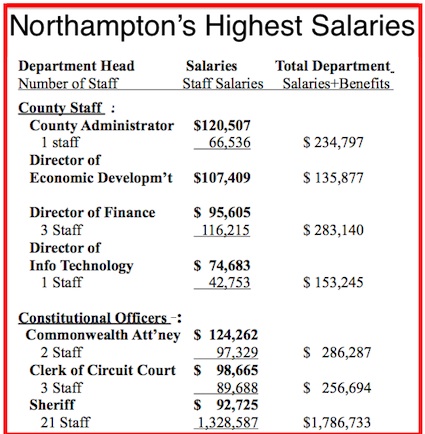 By MARY MILLER
By MARY MILLER
Citizens for a
Better Eastern Shore
July 7, 2014
Counties around the state are finishing up their budgets for the next fiscal year. This is the time of year we can easily see where our county’s tax dollars are going – and take a look at similar expenses for the counties around us.
This year, and not for the first time, Northampton County wins the spendthrift award. Compared to Accomack County, and compared also to several eastern Virginia counties with similar populations, Northampton spends more per person for county administration, public safety and debt service, and provides more education dollars per student than most of the others. Northampton also tops the list in per-person local tax revenue collected.
When comparing expenses of the two Eastern Shore counties with a disparity of population (Accomack’s population is about three times Northampton’s), it’s more informative to compare the costs for what are assumed to be similar services on a per-person basis. For instance, Northampton collects almost $1,700 in local tax revenue per person, while Accomack collects about $1,100. Assuming that the actual costs of several locally funded services are similar from one county to the next, it would be logical that the same costs spread over a larger population would make the services less costly per person. All things being equal, one might assume that the total costs for many services in Accomack could be as much as three times as much as in Northampton, which has one-third the number of residents. [Read more…]
COMMENTARY
Hope for Sea Turtles, One Hatchling at a Time
By WAYNE CREED
June 30, 2014
A few years ago, when my work was based near Oceana Naval Air Station, one of my guilty pleasures was to sneak over to the Virginia Aquarium during lunch and hang out by the loggerhead turtle exhibit. Light and graceful swimmers, those blithe movements belie the power and strength held in their huge heads and jaws which are easily able to crush right through a conk shell. Another guilty pleasure is being able to treat my wife to some sort of pampering from the wonderful Breezes Day Spa in Cape Charles. Recently, these two guilty pleasures sort of came together to help shed light on a scientific mystery that had been plaguing marine biologists for some time.
After Loggerhead sea turtles hatch, they begin a frantic race off the beach into the surf. Once into the sea, the hatchlings start a journey that lasts several years, and when it’s finished, leaves them across the Atlantic near the Canary Islands. How they get there, however, has always remained a mystery. The time between hatching and rediscovery has always been referred to as the turtle’s “lost years.”
For some time now, marine scientists at NOAA have been using satellite tracking devices to monitor the travels of adult turtles. The transmitters are glued to the shell, and location data is beamed back and captured. This worked fine for adults, but young turtles grow so quickly that their shells shed whatever scientists tried to use to attach the transmitters. It was here that a professional spa technician, like those working at Breezes, provided a breakthrough.
Marisol Marrero, who is a nail salon technician at Not Just Nails in Boynton Beach, Florida, had a customer, Jeanette Wyneken of Florida Atlantic University, who was also part of NOAA’s Southeast Fisheries Science Center study tracking loggerheads. While getting her nails done, Wyneken was reflecting on the problem of getting the transmitters to stick to the baby turtles’ shells, which she mentioned are made out of a protein called keratin, the same material as fingernails. Ms. Marrero suggested that they try a similar technique that the salons used for attaching artificial nails: try using an acrylic base coat. Wyneken took the suggestion back to the lab and tried it. It worked. This serendipitous trip to the salon has helped to finally shed new light on sea turtles’ “lost years.”
COMMENTARY: Heroes, a Small World, and Nonsense
By ANDY ZAHN
June 23, 2014
My mom and dad were my heroes along with our fantastic generals and admirals of WW II who accomplished what wouldn’t be possible today.
Mom’s father got killed at work, leaving a widow with seven young kids. The eldest had to quit school and earn money to support the family, as there was no welfare or food stamps. Mom dropped out in 8th grade and became a playground director at the school she had attended. The job title today would be gym teacher. She lived in Down Neck, Newark, NJ, which was all Irish, and she taught all the Irish police, fire, and politicians. She went on to be a paymaster in a shipyard and worked in teen recreation and child care and nurseries. She was the secretary of the Irvington, NJ, Democratic Club.
Dad left school in 9th grade from the German neighborhood of Newark. He joined the army in WW I and became an officer. He became a city firefighter and retired as a deputy chief. In WW II he joined the Navy and left as a full commander. When WW II started he trained the soldiers from Fort Monmouth who were now firefighters. The fire engine from Fort Monmouth came to the Irvington drill tower where he taught firefighting and safety. He taught all 1,000 Irvington teachers first aid in case we were bombed by the Germans. He organized, trained, and equipped the CD Firefighters in Irvington.
The Irvington Fire Chief was James Thompson, Jr., who was way ahead of the curve. In 1938 he came up with the idea of an Emergency Squad that would respond to every kind of an emergency with a main mission of saving lives. My dad was put in charge of the Squad for the 84 hours a week he was on duty. It was a beautiful white fire engine with a huge spotlight and a powerful, very loud motor. It carried all kinds of equipment for fighting fires and saving lives. There were probably around seven husky men on the Squad, all first aiders, and one man was a police officer who dressed and worked like a fireman but who wore a police badge, had a pair of handcuffs, and was armed. The men on the squad got little sleep because they averaged three calls per night. [Read more…]
LETTER: Flag Mural Is Uplifting and Timely
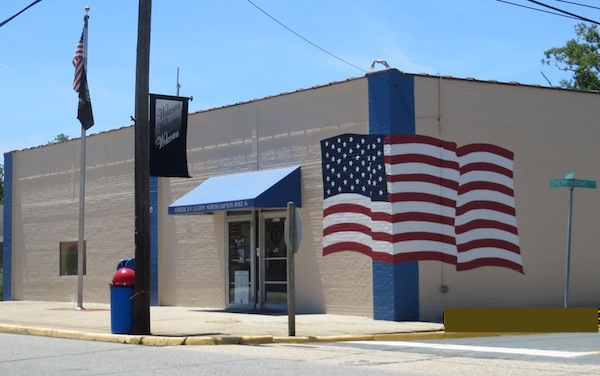
Flag appears to float on American Legion building — a “trompe l’oeil,” or trick to the eye. (Photo: Wendy Martin)
DEAR EDITOR,
June 23, 2014
On a recent errand off Route 13 into Cheriton we were awestruck by the newly unfurled mural flying’ and caressing the northeast corner facade of American Legion Post 56. So impressed by the artwork and trompe l’oeil undulation of our national flag, I suggested that the Wave capture the image — especially at this time of year. When you replied that community input is welcome, this subscriber became motivated to photograph the site and get the scoop, thanks to dedicated Commander “Captain” Dave Steward, whose inspiration and that of First Vice Commander Joe Vaccaro it is.
Late in April our soggy spring finally permitted designer artist Mike Boan of Parksley to airbrush his installation. Successful fundraisers had followed on the heels of the Post’s power washing, tedious scraping of the formerly institutional-looking grey, and repointing and painting of the brick walls.
Such an uplifting patriotic endeavor is, above all, a handsome reminder of those currently serving our country, our veterans who the Post serves, and in memory of those who paid the ultimate price. Illumination at nightfall presents another moving dimension.
Dave admits there’ve been many compliments, especially from folks arriving from Cherrystone Campground. And in spite of a very productive year in office he has even more upbeat plans in store.
WENDY MARTIN
LETTER: Thank You to American Legion Auxiliary
June 23, 2014
DEAR EDITOR,
American Legion Post 56 has been the site for a number of positive and uplifting events over the past weeks including the National Commander’s visit, the Freedom Hunter’s Project for Wounded Warriors, and several Legion- related events to raise monies for community projects. However, May 30 took on a very special meaning for all local veterans when the Post 56 American Legion Auxiliary honored them with their special yearly dinner.
The event was attended by over 100 veterans and their families and featured a four-course meal that several veterans said surpassed the previous year’s menu. President Susan Moyers personally greeted everyone, and Irene Morris made sure that every veteran received a handmade boutonniere at the door. Post 56 Bar Manager Susan Bagwell Miller ensured that those in attendance had the finest refreshments, and chefs Hania Steward and Sandra Salopek were responsible for the wonderful meal along with several members of The Sons of the Legion. [Read more…]

